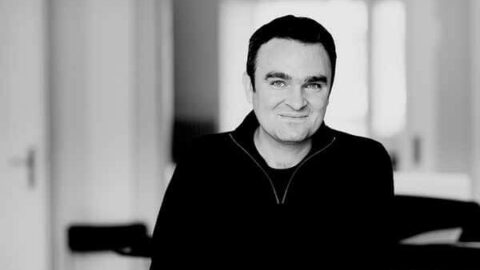 On Friday, October 26, the Berlin Philharmonic took to the stage to perform works by Benjamin Britten, Claude Debussy, Maurice Ravel, and Jörg Widmann. Born in 1973, Widmann is a prolific German clarinetist and composer who has performed widely as a soloist and whose pieces have been played around the world. Studying clarinet first at the Academy of Music in Munich and then at Juilliard, Widmann also studied composition with Wilfried Hiller, Heiner Goebbels, Wolfgang Rihm, and Hans Werner Henze, who passed awaylate last week. On Friday’s program was Widmann’s violin concerto, written in 2006 and premiered in 2007 by the Young German Philharmonic. The violinist was Christian Tetzlaff, the same violinist who premiered the piece five years ago.
On Friday, October 26, the Berlin Philharmonic took to the stage to perform works by Benjamin Britten, Claude Debussy, Maurice Ravel, and Jörg Widmann. Born in 1973, Widmann is a prolific German clarinetist and composer who has performed widely as a soloist and whose pieces have been played around the world. Studying clarinet first at the Academy of Music in Munich and then at Juilliard, Widmann also studied composition with Wilfried Hiller, Heiner Goebbels, Wolfgang Rihm, and Hans Werner Henze, who passed awaylate last week. On Friday’s program was Widmann’s violin concerto, written in 2006 and premiered in 2007 by the Young German Philharmonic. The violinist was Christian Tetzlaff, the same violinist who premiered the piece five years ago.

The violin concerto begins with a powerful opening statement by the soloist. This theme reverberates around the orchestra and sets up a motivic ground from which the rest of the piece seems to emerge. The violinist then slowly leads the audience through a portrait of sound that is always evolving and shifting through Widmann’s masterful orchestration and use of harmony. This feeling of being led comes from the almost continuous playing of the violin, which seems to serve as a beacon of light as the soundscape around it molds and changes shape. In fact, the only moment the violin stops playing for an extended period of time is at the false ending. Here, silence permeates the entire orchestra for what feels like 30 seconds, creating a significant moment of tension in the piece as the audience waits impatiently for the soloist to resume playing. Throughout the concerto, the violin is the one thing the audience can hold onto, even during the more tumultuous—or even silent—sections of the piece.
Widmann uses soft dynamics to great effect in order to achieve a specific timbral quality in his concerto. Rather than creating a thick and hard-to-decipher wall of sound, Widmann opts instead to focus on a sparser orchestration, reserving a heavier orchestration for momentary sections that temporarily obscure the soloist in a mass of sound. Most of the piece is at a softer dynamic level that allows the audience to clearly hear the techniques Widmann uses to obtain a particular sound. Listening to the piece feels like a study of orchestration, and Widmann’s thorough use of extended techniques throughout the orchestra is both thrilling and somewhat exhausting to hear (it seems the only extended technique not used by the string section was hitting the body of their instruments!).
Throughout the piece, there is a clear struggle between the soloist and the orchestra. Often, the violin is heard one or two semitones away from the harmonic plane of the orchestra, giving a feeling of separation between the two. As the concerto progresses, the violin attempts to find its way to the harmonic area of the orchestra. It is only at the end of the piece that the tension built by the separate harmonic areas is released and the differences between the soloist and orchestra are finally reconciled.

I can’t help but feel that Widmann owes a lot in his violin concerto to Shostakovich. Widmann’s piece is very similar to the first movement of Shostakovich’s violin concerto. In both, there is the feeling of the soloist slowly leading the audience as the orchestra evolves around them. Also, the soloist almost never stops playing and there are no enormous, grand climaxes throughout the piece. Even the thematic material feels somewhat related between Shostakovich and Widmann. In addition, Widmann’s writing for the violin brings to mind the music of Eugène Ysaÿe: static moments combine with virtuosic episodes in a highly romantic style.
Widmann’s music seems to straddle two separate worlds. At times, his writing is very romantic, giving rise to soaring violin lines and thick orchestration reminiscent of the late 19th, early 20th century. At other moments, timbre and color take precedent, calling to mind the music of Ligeti or Penderecki. However, Widmann’s voice manages to shine through and his combination of these two different ways of using the orchestra to achieve the particular sound he wants feels natural.
The other pieces performed by the Berlin Philharmonic were Britten’s Passacaglia from Peter Grimes, Debussy’s La Mer, and the crowd-pleasing La Valse by Ravel. Widmann’s violin concerto was programmed for the first half of the concert between the Britten and Debussy, a smart move since most in the audience were probably there for the second half. Whether Widmann’s placement was made for that reason or not, the concert had a natural flow to it. Widmann’s style and use of lyricism, timbre, and orchestration acted as the perfect bridge between Britten and Debussy.
An amazing orchestra and soloist combined with Widmann’s wonderful orchestration and masterful writing of the violin added up to a highly enjoyable performance of his violin concerto. Among the big name pieces on the program, Widmann’s violin concerto definitely stood out as highly unique and incredibly refreshing to hear.
—
Sam Reising is studying music composition at New York University. Follow him on Twitter: @samreising.
























